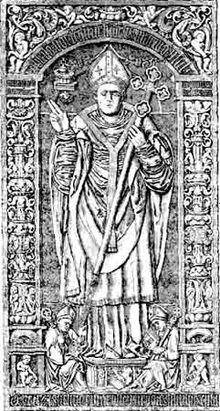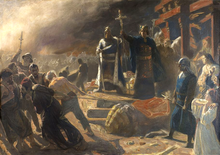Absalon
Absalon | |
|---|---|
| |
 Absalon's grave effigy | |
| Diocese |
|
| Predecessor | |
| Successor |
|
| Personal details | |
| Born | c. 1128 near Sorø |
| Died | 21 March 1201 (aged 72–73) Sorø |
| Buried | Sorø Abbey |
Absalon (c. 1128 – 21 March 1201) was a Danish statesman and prelate of the
Absalon was born into the powerful Hvide clan, and owned great land possessions. He endowed several church institutions, most prominently his family's Sorø Abbey. He was granted lands by the crown, and built the first fortification of the city that evolved into modern-day Copenhagen. His titles were passed on to his nephews Anders Sunesen and Peder Sunesen. He died in 1201, and was interred at Sorø Abbey.
Early life
Absalon was born around 1128 near
Absalon first appears in
Bishop and advisor
Absalon was a close counsellor of Valdemar, and chief promoter of the Danish
Wendish campaigns

The first expedition against the Wends conducted by Absalon in person, set out in 1160.[2] These expeditions were successful, but brought no lasting victories.[1] What started out as mere retribution, eventually evolved into full-fledged campaigns of expansion with religious motives.[5] In 1164 began twenty years of crusades against the Wends, sometimes with the help of German duke Henry the Lion, sometimes in opposition to him.[1]
In 1168 the chief Wendish fortress at

The destruction of this chief sally-port of the Wendish pirates enabled Absalon to considerably reduce the Danish fleet. But he continued to keep a watchful eye over the Baltic, and in 1170 destroyed another pirate stronghold, farther eastward, at Dziwnów on the isle of Wolin. Absalon's last military exploit came in 1184, off Stralsund at Whitsun, when he soundly defeated a Pomeranian fleet that had attacked Denmark's vassal, Jaromar of Rügen.[2]
Policies
Absalon's main political goal was to free Denmark from entanglements with the
Absalon built churches and monasteries, supporting international religious orders like the
Archbishop of Lund
Archbishop Eskil returned from exile in 1167. Eskil agreed on
Valdemar died in 1182 and was succeeded by his son, Canute VI, whom Absalon also served as counsellor.[5] Under Canute VI, Absalon was the chief policymaker in Danish politics.[4] Absalon kept his hostile attitude to the Holy Roman Empire. On the accession of Canute VI in 1182, an imperial ambassador arrived at Roskilde to get the new king to swear fealty to Frederick Barbarossa, but Absalon resolutely withstood him.[2]
Death
When Absalon retired from military service in 1184 at the age of fifty-seven, he resigned the command of fleets and armies to younger men, like Duke Valdemar, the later king Valdemar II. He instead confined himself to the administration of the Danish empire.[1] In 1192, Absalon made his nephew Peder Sunesen his successor as Bishop of Roskilde, while his other nephew Anders Sunesen was named the chancellor of Canute VI.[5] Absalon died at Sorø Abbey on 21 March 1201, 73 years old, with his last will granting his personal holdings to the Abbey, apart from Fjenneslev which went to Esbern Snarre. He had already given Copenhagen to the Bishopric of Roskilde.[1] Absalon was interred at Sorø Abbey,[5] and was succeeded as Archbishop of Lund by Anders Sunesen.[3]
Legacy

Saxo Grammaticus' Gesta Danorum was not finished until after the death of Absalon,[3] but Absalon was one of the chief heroic figures of the chronicle, which was to be the main source of knowledge about early Danish history.[5] Absalon left a legacy as the foremost politician and churchfather of Denmark in the 12th century.[3] Absalon was equally great as churchman, statesman, and warrior. His policy of expansion was to give Denmark the dominion of the Baltic for three generations. That he enjoyed warfare there can be no doubt; yet he was not like the ordinary fighting bishops of the Middle Ages, whose sole indication of their religious role was to avoid the shedding of blood by using a mace in battle instead of a sword. Absalon never neglected his ecclesiastical duties.[2]
In the 2000s, "Absalon" was adopted as the name for a class of
References
- ^ a b c d e f g h i j k l m n Carl Frederik Bricka (ed.), Dansk Biografisk Lexikon, vol. I [Aaberg – Beaumelle], 1887. A.D. Jørgensen, "Absalon" pp.70–81
- ^ a b c d e f g h i j k l One or more of the preceding sentences incorporates text from a publication now in the public domain: Bain, Robert Nisbet (1911). "Absalon". In Chisholm, Hugh (ed.). Encyclopædia Britannica. Vol. 1 (11th ed.). Cambridge University Press. pp. 73–74.
- ^ a b c d e f g h i j Absalon at Gyldendals Åbne Encyklopædi
- ^ ISBN 978-87-12-04259-4
- ^ a b c d e f g h i j k l m n Stefan Pajung, Artikel: Absalon ca. 1128–1201, Aarhus University, 20 June 2009
- ^ Kirkelove at Gyldendals Åbne Encyklopædi
- ^ "Forsvaret.dk". Archived from the original on 10 February 2009. Retrieved 25 March 2010.
- ^ Absalon Class Combat / Flexible Support Ship, Denmark naval-technology.com Archived 15 September 2008 at the Wayback Machine
Further reading
- Saxo, Gesta Danorum, ed. Holder (Strassburg, 1886), books xvi.
- Steenstrup, Danmarks Riges Historie. Oldtiden og den ældre Middelalder, pp. 570–735 (Copenhagen, 1897–1905).
- Absalon's Testamentum, in Migne, Patrologia Latina 209,18.
External links
- . New International Encyclopedia. 1905.
- . The American Cyclopædia. 1879.
